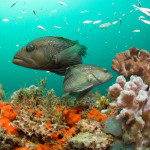By guest writer Elizabeth Weinberg, social media coordinator and editor/writer, NOAA Office of National Marine Sanctuaries
For more than 40 years, national marine sanctuaries have worked to protect special places in America’s ocean and Great Lakes waters, from the Hawaiian Islands to the Florida Keys, from Lake Huron to American Samoa. Backed by one of the nation’s strongest pieces of ocean conservation legislation, the National Marine Sanctuaries Act, the sanctuaries seek to preserve the extraordinary beauty, biodiversity, historical connections and economic productivity of our most precious underwater treasures. And — lucky for you — most of these places are accessible to recreational divers. Sanctuary waters are filled with unique ecosystems, harboring a spectacular array of plants, animals and historical artifacts, all waiting to be explored. National marine sanctuaries belong to everyone, so dive in.
Gray’s Reef National Marine Sanctuary
Dive into the ocean off the coast of Georgia, and you’ll find yourself in a startlingly colorful setting. Swim past sea stars clinging to vibrant orange gorgonians, lobsters nestled between scattered rock ledges and vivid sponges. Look closely and you might see a nurse shark or a loggerhead sea turtle tucked in against the ocean floor.
This is Gray’s Reef National Marine Sanctuary, a 22-square-mile area protecting a dense carpet of fan corals, sponges, barnacles, crabs, lobsters, snails, shrimp and other organisms, collectively known as a “live-bottom†reef. Gray’s Reef is home for more than 200 species of fish, including black sea bass, snappers, groupers and mackerels, and threatened loggerhead sea turtles visit the reef year-round to forage.
When diving, help protect this sanctuary by practicing good ocean etiquette. Streamline your equipment; keep a safe distance from marine animals; and do not touch or remove anything from the reef — removing even a rock or a shell can disrupt this fragile ecosystem. Anchoring is prohibited in the sanctuary; drift diving will allow you to safely explore this amazing place.
Cover image credit: Greg McFall/NOAA
The post Exploring National Marine Sanctuaries Gray’s Reef appeared first on Scuba Diver Life.










